
The Charles H. Moore House is a historic residence in the city of Wyoming, Ohio, United States. Built in 1910 and home for a short time to a leading oilman, it has been designated a historic site.

The Dunlap House is a historic house at 101 Grandview Avenue in Clarksville, Arkansas. It is a two-story wood frame American Foursquare structure, set on a tall stone foundation on a highly visible lot near the city center. Its porch, uncharacteristic for the Foursquare style, extends only across half the front, and curves around to the left side; it is supported by Tuscan columns. The house was built about 1910 to a design by noted Arkansas architect Charles L. Thompson.

Hillside, also known as the Charles Schuler House, is a mansion overlooking the Mississippi River on the east side of Davenport, Iowa, United States. It has been individually listed on the National Register of Historic Places since 1982, and on the Davenport Register of Historic Properties since 1992. In 1984 it was included as a contributing property in the Prospect Park Historic District.

The Davis House is a historic house at 212 Fulton Street in Clarksville, Arkansas. It is a 2+1⁄2-story wood-frame American Foursquare structure, with a hip roof, weatherboard siding, and a foundation of rusticated concrete blocks. The roof has flared eaves with exposed rafter ends, and a front-facing dormer with a Flemish-style gable. The porch extends across the front and curves around to the side, supported by Tuscan columns. The house was built about 1905 to a design by noted Arkansas architect Charles L. Thompson.
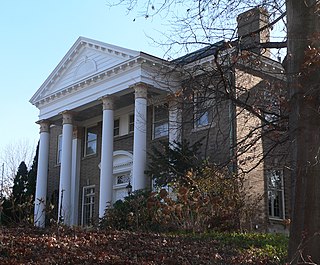
The Carl Herget Mansion is a historic house located at 420 Washington Street in Pekin, Illinois. The house was built in 1912 for Carl Herget, a businessman and member of one of Pekin's most prominent families. Prominent Peoria architectural firm Hewitt & Emerson designed the Classical Revival house; the style was in vogue in the early twentieth century, mainly due to its use at the 1893 Columbian Exposition. The front entrance features a full-height porch topped by a pediment and supported by four Corinthian columns and two Corinthian pilasters. The entrance itself is flanked by Ionic pilasters and topped by a fanlight and dentillated segmental pediment. The south and east sides each feature porches with Doric columns and balustrades.

The John C. Anderson House is a historic house located at 920 W. Breckenridge St. in Carlinville, Illinois. The house's first floor was built in 1883, while its second floor was added in 1892. The first floor has an Italianate design featuring tall, narrow windows, an asymmetrical porch with paired columns, paired brackets, and a dentillated cornice. The second floor is designed in the Queen Anne style and includes a square tower with stick style framework, a multi-component roof with gabled dormers, and a stained glass window with a decorative wooden frame. Local banker C.H.C. Anderson built the house for his son John C. Anderson as a wedding gift; John and his wife Lucy lived in the house until their deaths in the 1930s.

The Edith Chipman House is a historic house located at 201 West 3rd Street in Vermont, Illinois. Edith Chipman, the widow of a wealthy local farmer and lumber seller, had the house built in 1912. The house had a four-over-four plan, typified by four equally sized rooms and a central hallway on both of its two stories, with American Foursquare exterior features and Classical Revival details. The house's cubelike shape and its hip roof with hipped dormers are typical of American Foursquare homes, though the interior plan is not typical of Foursquare architecture. Its Classical Revival elements include the Tuscan columns supporting the porch, the entablatures on the inside of the doors and windows, and the staircase's balusters and newel posts.

The Henry H. Page House is a historic house located at 221 North Union Street in Vermont, Illinois. Horse breeder Henry H. Page had the house built for his family in 1912–13. The house's design reflects a contemporary trend which architectural historian Alan Gowans described as Picturesque Eclectic; while its form distinctly fits a recognizable style, in its case the American Foursquare, its ornamentation borrows from multiple different styles. The large front gable dormer, which includes a horseshoe arch opening and decorated spandrels, is a Queen Anne feature. The cornice features both bracketing and stickwork, decorative elements of the Italianate and Stick styles respectively. The brick piers supporting the front porch come from the American Craftsman style, while the leaded windows are Classical Revival elements.

The Stevens House is a historic house located at 140 East Main Street in Tiskilwa, Illinois. John Stevens, a wealthy local businessman, built the house in 1842. The original house had a Greek Revival design highlighted by a full porch with columns. In 1910, the house was redesigned in the Classical Revival style, bringing it in line with contemporary trends. The house's new features included a new porch, a bay window with Classical columns, a dormer projecting from the front of the roof, and a frieze and cornice.

The Hargis House is a historic house built in 1920 which was listed on the National Register of Historic Places in 1996. It is located at 300 E. Cedar St. in Franklin, Kentucky.

The Jefferson Avenue Historic District in Janesville, Wisconsin is a historic neighborhood east of the downtown of mostly middle-class homes built from 1891 to the 1930s. It was added to the State and the National Register of Historic Places in 2006.
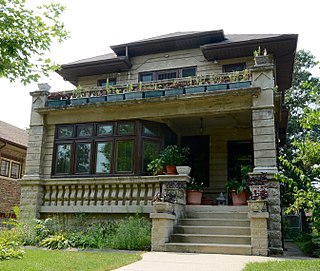
The Anton E. Hanson House is a historic house at 7610 S. Ridgeland Avenue in the South Shore neighborhood of Chicago, Illinois. Real estate developer Anton E. Hanson had the house built for his family in 1912. The house also allowed Hanson to test concrete block construction, an increasingly popular method that Hanson later used in two other houses. Architect Perley Hale designed the American Foursquare house. Hale's design added decorative stone features to the concrete exterior, including balustrades on the porch and balcony and a cornice below the balcony.

The Theodore Rozek House is a historic house at 6337 N. Hermitage Avenue in the Edgewater neighborhood of Chicago, Illinois. The house was built in 1908 for Theodore Rozek, a printer and German immigrant, and his family. Architect Clarence Hatzfeld designed the original house in the American Foursquare style, a popular vernacular style of the early twentieth century. Like many other Foursquare homes, the house had a square shape and was topped by a hip roof with a dormer. In the mid-1920s, architect Andrew E. Norman designed an addition for the front of the house; this addition was inspired by the Better Homes movement, which sought to bring high-level architecture to working-class homes. The addition replaced the original front porch with a semi-circular porch supported by its original columns, distinguishing the house from its neighbors.
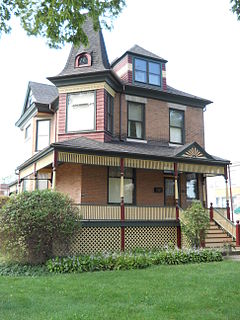
The Harry H. Nichols House is a historic house at 216 S. 4th Avenue in Maywood, Illinois. The house was built in 1894 for Harry H. Nichols, the former postmaster of Maywood and the son of village founder William T. Nichols. It was designed in the Queen Anne style, which was popular in the late nineteenth century; along with the Jacob Bohlander House, it is one of two large, formal Queen Anne homes in Maywood. The house's design includes a wraparound front porch with a balustrade, a gable with a sunburst design above the entrance, a projecting gabled bay on its south side, and a rectangular tower at its southeast corner. Neoclassical elements such as urns, columns, and cornices adorn its interior; these were most likely inspired by the architecture of the recent Columbian Exposition.
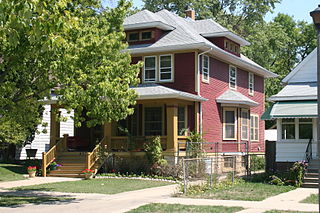
The William and Caroline Gibbs House is a historic house at 515 N. 3rd Avenue in Maywood, Illinois. The American Foursquare house was built in 1907. The house has a standard Foursquare layout with a square shape, a pyramidal roof with dormers, and a front porch. In keeping with its style, its interior has a functional layout with a central staircase, an easily accessible kitchen, and built-in furniture. As was common in Foursquare homes, the house has simple geometric detailing inspired by the Craftsman movement, such as wood trim, leadlight windows, and square columns.

The Joseph P. O. Sullivan House is a historic house at 142 S. 17th Avenue in Maywood, Illinois. The house was built circa 1895 by the Proviso Land Association for Joseph P. O. Sullivan. The Proviso Land Association was the second land developer to invest in Maywood, after the Maywood Company; most homes built by the Association have been demolished, making the Sullivan House a rare example of their work. Like many of the Association's homes, the Sullivan House has an American Foursquare design. The house has a rectangular two-story layout with a front porch, a projecting bay on one side, a hip roof, and a dormer with a classical Palladian window.

The William Frangenheim House is a historic house at 410 N. 3rd Avenue in Maywood, Illinois. The house was built in 1906 on a plot previously owned by the Maywood Company, the development company that planned Maywood. It is designed in the American Foursquare style, a vernacular style which was used in many Maywood houses of the period. Like most Foursquare homes, the house has a square two-story layout with a front porch and a hip roof with a dormer. In keeping with its utilitarian style, the house has little external decoration; its interior features Craftsman-inspired wood trim, though it is still relatively plain.

The Caroline Millward House is a historic house at 502 N. 5th Avenue in Maywood, Illinois. The house was built circa 1906 for owner Caroline Millward. It has an American Foursquare design, a simplified style popular in the early twentieth century, with Prairie School elements. The 2+1⁄2-story house has a typical Foursquare layout, with a rectangular shape, a front porch supported by wide piers, a glazed porch on one side, and a hip roof with a front-facing dormer. The horizontal emphasis of the design is typical of the Prairie School, as are its bands of windows, wood trim, overhanging eaves, and built-in furniture.
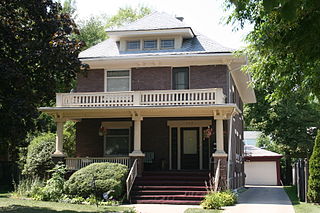
The Albert Soffel House is a historic house at 508 N. 5th Avenue in Maywood, Illinois. The two flat house was built in 1905 for original owner Albert Soffel. It has an American Foursquare design, a utilitarian style popular in the early twentieth century, with Arts and Crafts and Neoclassical ornamentation. The house has a typical Foursquare plan with a rectangular layout, a front porch supported by three columns, and a hip roof with a dormer. Its decorative features include Ionic styling on the porch columns, dentillation and brackets on the porch roof, additional bracketing along its eaves, and multiple stained glass windows.

The John Robertson, Jr., House is a historic house at 145 W. Main Street in Barrington, Illinois. The house was built in 1898 for John Robertson, Jr., a local banker and a member of Barrington's village board. Carpenter Fred Lines built the house, which has an American Foursquare plan with Neoclassical details. The 2+1⁄2-story house has a roughly rectangular layout with a service addition, front and side porches, and a dormer projecting from the front of its hip roof, a typical Foursquare layout. Its Neoclassical elements include Corinthian columns supporting the porches, swags and garlands adorning several windows, and multiple Palladian windows.























